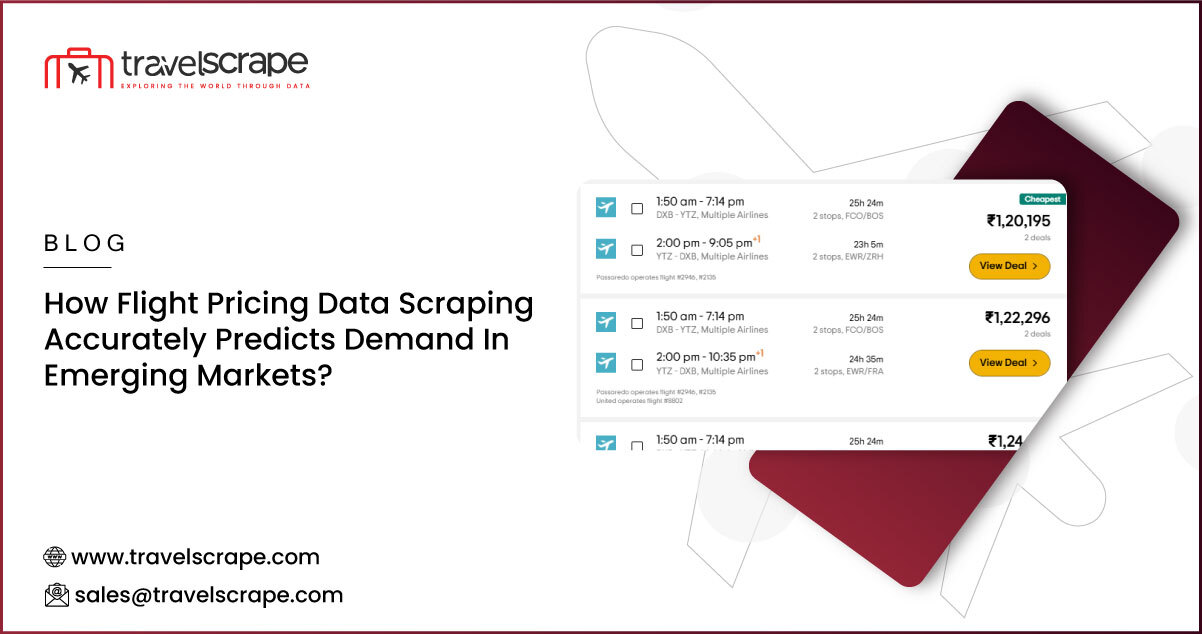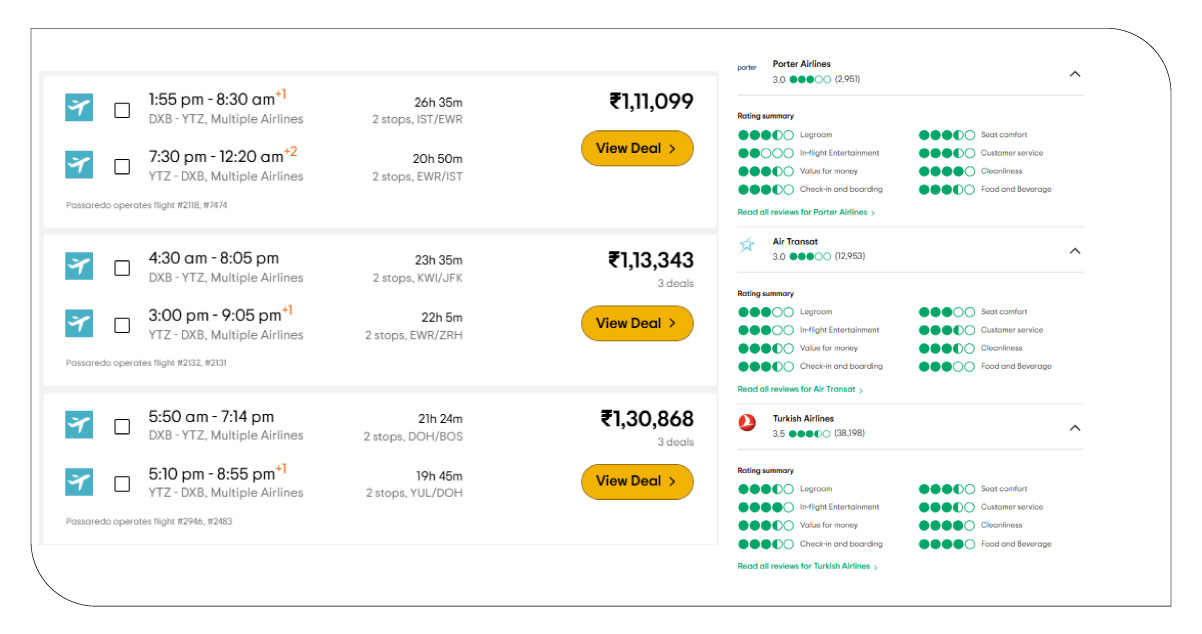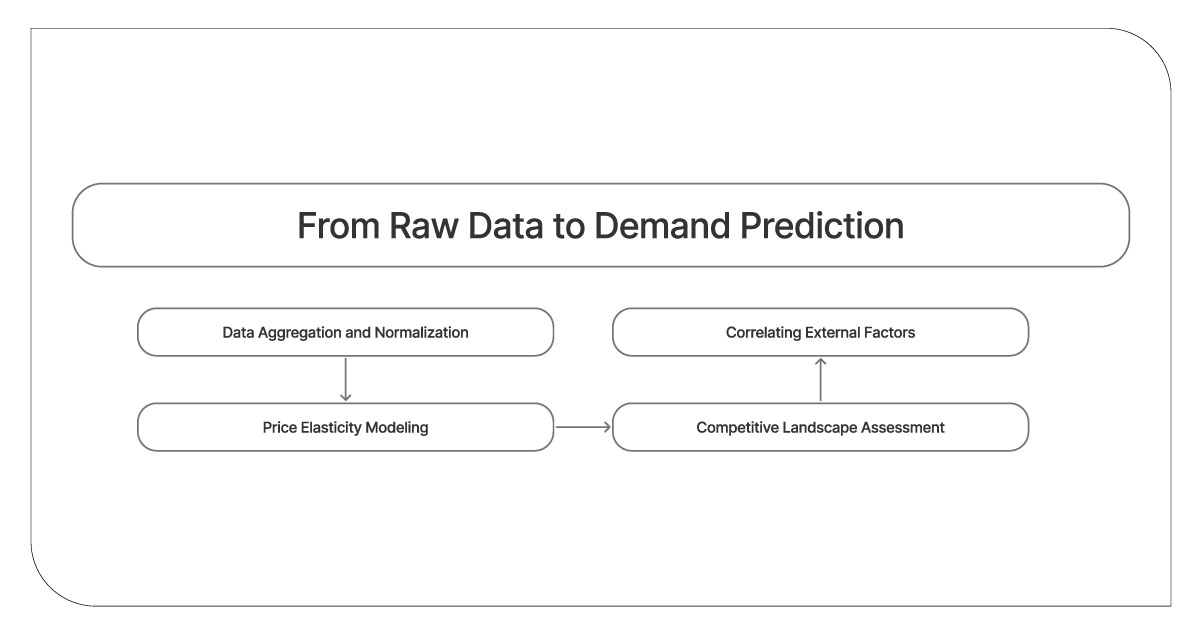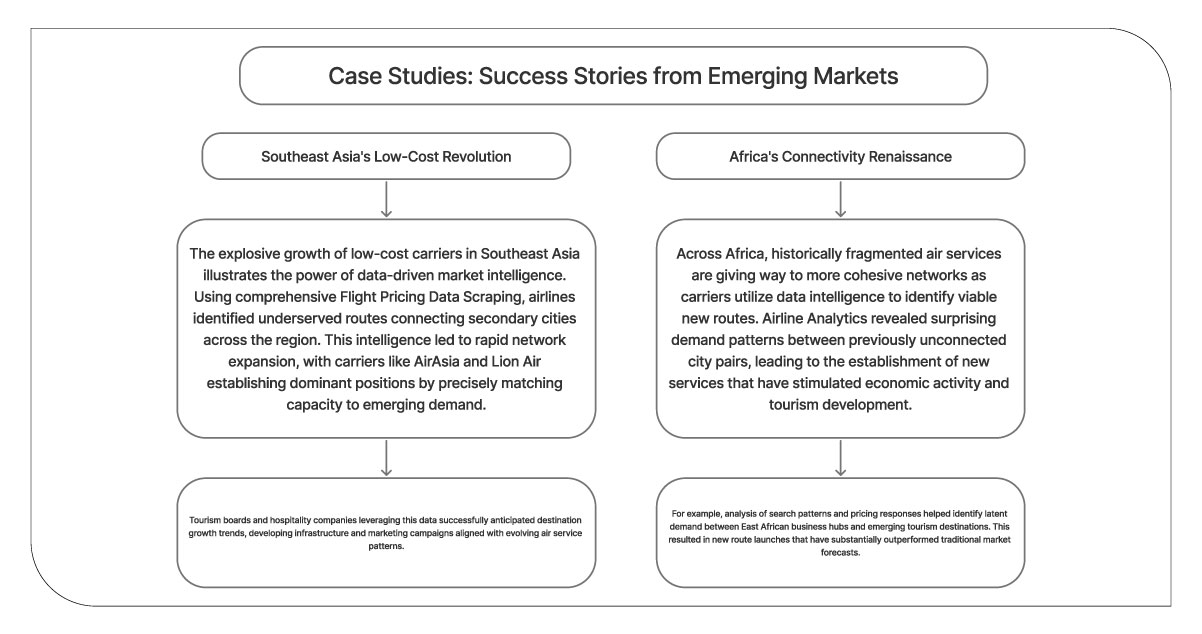How Flight Pricing Data Scraping Accurately Predicts Demand In Emerging Markets?

Introduction
In today's hyper-connected global economy, understanding travel patterns and consumer behavior is essential for businesses seeking a competitive edge. Flight Pricing Data Scraping has emerged as a revolutionary tool transforming how companies analyze, predict, and respond to market dynamics in the aviation industry. This sophisticated approach to data gathering provides unprecedented insights into pricing fluctuations, booking patterns, and consumer preferences, which are particularly valuable when exploring untapped potential in emerging travel destinations.
The Evolution of Aviation Intelligence

The travel industry has always relied on data to make strategic decisions. However, the traditional methods of gathering information were often slow, limited in scope, and failed to capture real-time market conditions. With modern Aviation Big Data solutions, companies can now access comprehensive information that reveals intricate market dynamics previously hidden from view.
Flight Data Scraping represents the next evolution in this intelligence gathering process. By systematically collecting and analyzing airfare information across multiple carriers, routes, and booking platforms, businesses gain access to a treasure trove of actionable insights. This wealth of information becomes especially valuable when examining emerging markets where conventional market research data may be scarce or unreliable.
Understanding the Mechanics of Flight Data Intelligence
At its core, Flight Pricing Data Scraping involves the automated collection of fare information from airline websites, online travel agencies, and aggregator platforms. Advanced algorithms continuously monitor these sources, tracking real-time price movements, seat availability, and booking patterns. This process generates vast datasets that, when properly analyzed, reveal compelling patterns about consumer behavior and market trends.
Several key components make this approach particularly effective:
- Temporal Analysis: By monitoring how prices fluctuate from months before departure to last-minute bookings, analysts can identify airline pricing strategies and determine optimal booking windows.
- Competitive Intelligence: Tracking how carriers adjust pricing in response to competitors' actions provides insights into market positioning and revenue management strategies.
- Seasonal Variations: Identifying cyclical patterns helps predict high-demand periods and low seasons, allowing for more accurate Travel Demand Forecasting.
- Route Performance: Analyzing which routes experience price stability versus volatility helps identify established versus emerging travel corridors.
When these components are examined collectively through sophisticated Airline Analytics frameworks, businesses can develop nuanced understandings of market behavior that inform strategic decision-making.
The Emerging Market Opportunity
While developed travel markets like North America and Western Europe operate relatively predictably, Emerging Travel Markets present extraordinary opportunities and unique challenges.
Regions such as Southeast Asia, Sub-Saharan Africa, and parts of Latin America are experiencing rapid growth in air travel demand, driven by:
- Expanding middle classes with increasing disposable income.
- Growing infrastructure development.
- Liberalization of air travel regulations.
- Rising tourism awareness and destination marketing.
However, these markets often lack established data collection mechanisms and transparent pricing structures, making traditional market research approaches less effective. This is precisely where Flight Pricing Data Scraping demonstrates its value—providing visibility into historically opaque markets to outside observers.
From Raw Data to Demand Prediction

The journey from collecting flight pricing information to accurately forecasting travel demand involves several sophisticated analytical steps:
1. Data Aggregation and Normalization
Raw pricing data collected through Flight Data Scraping must be standardized to account for currency variations, booking classes, and amenities. This normalization process creates comparable datasets across different carriers and markets.
Integrating supplementary information from Global Flight Schedule Dataset resources enhances this foundation by providing context around capacity deployment and network planning strategies adopted by airlines serving these markets.
2. Price Elasticity Modeling
Analysts can develop elasticity models that quantify the relationship between fare levels and consumer demand by analyzing how booking volumes respond to price changes. These models become increasingly sophisticated when incorporating data from the Airline Price Change Dataset sources that track historical pricing adjustments and resulting market responses.
In emerging markets, price sensitivity often follows different patterns than established ones, making this analysis particularly valuable for companies seeking to optimize their pricing strategies.
3. Competitive Landscape Assessment
Understanding the competitive dynamics within specific markets provides critical context for demand forecasting. Flight Price Data Intelligence reveals how carriers position themselves within these emerging ecosystems and how consumers respond to various competitive scenarios.
4. Correlating External Factors
Advanced Travel Demand Forecasting models incorporate external variables that influence travel behavior, including:
- Economic indicators (GDP growth, currency exchange rates).
- Seasonal events and holidays.
- Weather patterns.
- Policy changes affecting visa requirements or travel restrictions.
- Infrastructure developments include new airports or expanded capacity.
When these factors are analyzed alongside pricing data, the resulting forecasts achieve remarkable accuracy, even in volatile emerging markets.
Case Studies: Success Stories from Emerging Markets

Discover how emerging regions harness data intelligence to unlock growth in aviation, tourism, and infrastructure, powered by precise analytics and real-time insights.
Southeast Asia's Low-Cost Revolution
The explosive growth of low-cost carriers in Southeast Asia illustrates the power of data-driven market intelligence. Using comprehensive Flight Pricing Data Scraping, airlines identified underserved routes connecting secondary cities across the region. This intelligence led to rapid network expansion, with carriers like AirAsia and Lion Air establishing dominant positions by precisely matching capacity to emerging demand.
Tourism boards and hospitality companies leveraging this data successfully anticipated destination growth trends, developing infrastructure and marketing campaigns aligned with evolving air service patterns.
Africa's Connectivity Renaissance
Across Africa, historically fragmented air services are giving way to more cohesive networks as carriers utilize data intelligence to identify viable new routes. Airline Analytics revealed surprising demand patterns between previously unconnected city pairs, leading to the establishment of new services that have stimulated economic activity and tourism development.
For example, analysis of search patterns and pricing responses helped identify latent demand between East African business hubs and emerging tourism destinations. This resulted in new route launches that have substantially outperformed traditional market forecasts.
The Technology Driving Advanced Insights

Modern Global Flight Price Trends Dataset relies on sophisticated technological infrastructure to collect, process, and analyze massive datasets. Key technological components include:
Web Scraping Architecture
Specialized crawlers continuously monitor thousands of airline and travel websites, regularly capturing pricing information. These systems must navigate increasingly complex website structures and overcome various anti-scraping measures online platforms employ.
Machine Learning Models
Advanced algorithms detect patterns and anomalies within pricing data that human analysts might miss. These models become increasingly accurate over time as they process more historical information, improving the precision of demand forecasts.
Real-Time Analytics Platforms
The actual value of Flight Data Scraping emerges when insights can be generated and acted upon quickly. Modern analytics platforms process incoming data streams continuously, allowing for the immediate identification of emerging trends or market opportunities.
Predictions for Travel Trends 2025
As we look toward the future, several key developments are likely to shape how flight pricing data influences market strategies in emerging economies:
- Hyper-Personalization: Airlines will increasingly use individual consumer data and market-level insights to develop personalized pricing strategies that maximize conversion rates and revenue.
- Predictive Disruption Management: Advanced analytics will help carriers anticipate and mitigate operational disruptions by optimizing reaccommodation strategies based on real-time demand patterns.
- Sustainability-Driven Decisions: As environmental concerns gain prominence, Travel Trends 2025 will increasingly emphasize using data to optimize flight operations for reduced environmental impact while meeting market demand.
- Secondary City Emergence: Data-driven route planning will accelerate air service development to secondary cities in emerging markets, creating new tourism and business destinations beyond traditional gateways.
The integration of additional data sources, such as Airport Amenities Dataset information, will further enhance these predictions by providing context around passenger experience factors that influence demand patterns.
Ethical Considerations and Data Governance
While Flight Pricing Data Scraping offers tremendous analytical power, its use raises essential ethical and legal considerations:
- Regulatory Compliance: Different jurisdictions apply varying rules regarding automated data collection from public websites. Responsible practitioners must ensure their methods comply with relevant regulations and respect the terms of service of the platforms they monitor.
- Privacy Protection: Although pricing data is generally public information, its collection and analysis must be conducted with appropriate privacy safeguards, particularly when combined with other data sources that might enable individual identification.
- Competitive Fairness: As Airline Data Scraping Services become more sophisticated, questions arise about competitive equity between large carriers with advanced analytical capabilities and smaller players with limited resources.
The Technological Horizon: What's Next for Flight Data Intelligence
The field of Flight Price Data Intelligence continues to evolve rapidly, with several emerging technologies poised to transform further how companies extract insights from pricing information:
Natural Language Processing
Advanced text analysis capabilities enable the extraction of pricing context from descriptive content, reviews, and social media discussions, adding qualitative dimensions to quantitative pricing data.
Computer Vision
Automated recognition of visual elements on booking platforms can identify promotional messaging, urgency indicators, and other conversion-focused elements that influence consumer decision-making.
Blockchain for Data Verification
Distributed ledger technologies are beginning to play a role in establishing the provenance and reliability of scraped data, ensuring analytical models are built on trustworthy information.
As these technologies mature, the accuracy and utility of Airfare Prediction models will continue to improve, particularly in complex emerging markets where traditional forecasting methods struggle.
How Travel Scrape Can Help You?
We specialize in transforming raw flight data into actionable business intelligence for companies operating in emerging markets. Our comprehensive suite of services helps you leverage the power of Flight Pricing Data Scraping to achieve your strategic objectives:
- Custom Data Collection: Tailored scraping solutions designed specifically for your target markets and competitive set.
- Advanced Analytical Models: Proprietary algorithms that transform raw pricing data into accurate demand forecasts.
- Market Entry Strategy Support: Data-driven recommendations for optimal route development and pricing positioning.
- Competitive Intelligence Dashboards: Real-time monitoring of competitor activities and market responses.
- Emerging Market Specialists: Regional experts who provide context and interpretation for data patterns in specific markets.
- Integration with Existing Systems: Seamless connection between our Airfare Prediction tools and your internal business intelligence platforms.
By partnering with us, you can access the same level of market intelligence previously available only to major global carriers. This allows you to compete effectively even in challenging emerging market environments.
Conclusion
In today's highly competitive global travel landscape, accurately predicting demand in emerging markets represents a crucial differentiator between market leaders and followers. Flight Pricing Data Scraping has emerged as an essential tool in this quest, providing unprecedented visibility into previously opaque markets.
Modern Travel Aggregators leverage these insights to create more dynamic and responsive business strategies, adapting quickly to emerging opportunities before competitors can respond. The sophisticated analytical frameworks developed through Travel Industry Web Scraping enable companies to identify untapped potential and optimize resource allocation for maximum impact.
Don't let your company fall behind in the race to understand and capture emerging market opportunities. Contact Travel Scrape today to discover how our specialized solutions can transform your approach to market intelligence and strategic planning.

